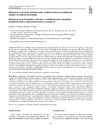Please use this identifier to cite or link to this item:
https://accedacris.ulpgc.es/handle/10553/9542
| Title: | Differences in diversity, structure, and variability between intertidal and subtidal meiofaunal assemblages | Other Titles: | Diferencias en la diversidad, estructura y variabilidad de la comunidad meiofaunal entre el medio intermareal y el submareal | Authors: | Riera, R. Núñez, Jorge L. Brito, María del Carmen Tuya, F. |
UNESCO Clasification: | 240106 Ecología animal | Keywords: | Intertidal Subtidal Granulometric composition Canary Islands |
Issue Date: | 2012 | Journal: | Ciencias Marinas | Abstract: | Meiofaunal assemblages from intertidal and shallow subtidal seabeds were studied at two sites (one dominated by volcanic sands
and the other by organogenic sands) at Tenerife (Canary Islands, NE Atlantic Ocean) throughout an entire year (May 2000–April 2001).
Specifically, we aimed (i) to test for differences in diversity, structure, and stability between intertidal and subtidal meiofaunal assemblages, and
(ii) to determine if differences in the meiofaunal assemblage structure may be explained by environmental factors (granulometric composition,
availability of organic matter, and carbonate content in sediments). A total of 103,763 meiofaunal individuals were collected, including
203 species from 19 taxonomic groups (Acari, Amphipoda, Cnidaria, Copepoda, Echinodermata, Gastrotricha, Isopoda, Insecta, Kinorrhyncha,
Misidacea, Nematoda, Nemertini, Oligochaeta, Ostracoda, Polychaeta, Priapulida, Sipuncula, Tanaidacea, and Turbellaria). Nematodes were
the most abundant taxonomic group. Species diversity was higher in the subtidal than in the intertidal zone at both sites, as a result of the larger
dominance of a few species in the intertidal zone. The meiofaunal assemblage structure was different between tidal levels at both sites, the
intertidal presenting greater temporal variability (multivariate dispersion) in the meiofaunal assemblage structure than the subtidal. Sediment
grain size, here quantified by the different granulometric fractions, explained the variability in meiofaunal assemblage structure to a greater
extent than the percentage of carbonates, a variable linked to sediment origin. This study revealed differences in diversity, assemblage structure,
and variability between intertidal and subtidal meiofauna. Se estudiaron las comunidades meiofaunales que habitan el medio intermareal y submareal somero adyacente en dos sitios (uno dominado por arenas terrígenas de origen volcánico y otro por arenas organógenas) de la isla de Tenerife (islas Canarias, NE del océano Atlántico) a lo largo de un año (mayo de 2000–abril de 2001). Específicamente, nos propusimos (i) evaluar las diferencias en la diversidad, estructura y estabilidad de la comunidad meiofaunal entre los estratos inter y submareales, y (ii) determinar si las diferencias en la estructura de la comunidad meiofaunal pueden ser explicadas por factores ambientales (composición granulométrica, disponibilidad de materia orgánica y contenido en carbonatos del sedimento). Se recolectó un total de 103,763 individuos meiofaunales pertenecientes a 203 especies y 19 grandes grupos taxonómicos (Acari, Amphipoda, Cnidaria, Copepoda, Echinodermata, Gastrotricha, Isopoda, Insecta, Kinorrhyncha, Misidacea, Nematoda, Nemertini, Oligochaeta, Ostracoda, Polychaeta, Priapulida, Sipuncula, Tanaidacea y Turbellaria). Los nematodos fueron el grupo más abundante. La diversidad de especies fue mayor en el medio submareal en relación con el intermareal para ambos sitios, como resultado de la dominancia de unas pocas especies en el estrato intermareal. La estructura de la comunidad meiofaunal fue distinta entre sitios y estratos, presentando el medio intermareal una mayor variabilidad temporal (dispersión multivariante) en la estructura de la comunidad meiofaunal en comparación con el medio submareal. La granulometría del sedimento, tipificado por las cantidades de las distintas fracciones granulométricas, contribuyó significativamente a explicar la variabilidad en la estructura meiofaunal, por encima del contenido en carbonatos de los sedimentos, variable ligada a la distinta naturaleza de cada sitio. En conclusión, este estudio ha mostrado diferencias en la diversidad, estructura y variabilidad de la comunidad meiofaunal entre los sistemas inter y submareales. |
URI: | https://accedacris.ulpgc.es/handle/10553/9542 | ISSN: | 0185-3880 | DOI: | 10.7773/cm.v38i4.2077 | Source: | Ciencias Marinas [ISSN 0185-3880], v. 38, p. 677-693 (Diciembre 2012) | Rights: | by-nc-nd |
| Appears in Collections: | Artículos |
SCOPUSTM
Citations
8
checked on Jun 8, 2025
WEB OF SCIENCETM
Citations
7
checked on Jun 8, 2025
Page view(s)
93
checked on Mar 9, 2024
Download(s)
221
checked on Mar 9, 2024
Google ScholarTM
Check
Altmetric
Share
Export metadata
Items in accedaCRIS are protected by copyright, with all rights reserved, unless otherwise indicated.
